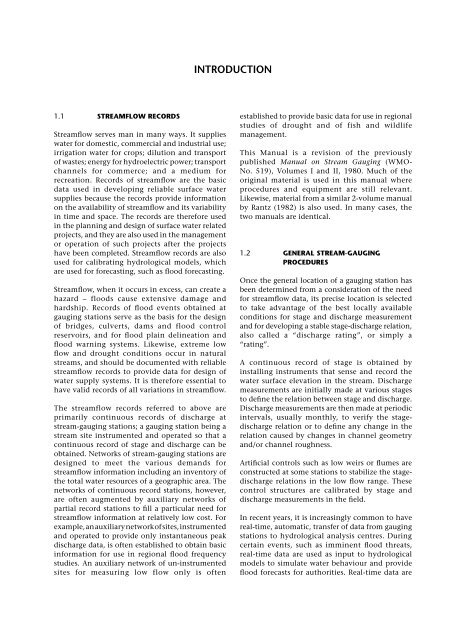MANUAL ON STREAM GAUGING - E-Library - WMO
MANUAL ON STREAM GAUGING - E-Library - WMO
MANUAL ON STREAM GAUGING - E-Library - WMO
- No tags were found...
Create successful ePaper yourself
Turn your PDF publications into a flip-book with our unique Google optimized e-Paper software.
INTRODUCTI<strong>ON</strong>1.1 Streamflow recordsStreamflow serves man in many ways. It supplieswater for domestic, commercial and industrial use;irrigation water for crops; dilution and transportof wastes; energy for hydroelectric power; transportchannels for commerce; and a medium forrecreation. Records of streamflow are the basicdata used in developing reliable surface watersupplies because the records provide informationon the availability of streamflow and its variabilityin time and space. The records are therefore usedin the planning and design of surface water relatedprojects, and they are also used in the managementor operation of such projects after the projectshave been completed. Streamflow records are alsoused for calibrating hydrological models, whichare used for forecasting, such as flood forecasting.Streamflow, when it occurs in excess, can create ahazard – floods cause extensive damage andhardship. Records of flood events obtained atgauging stations serve as the basis for the designof bridges, culverts, dams and flood controlreservoirs, and for flood plain delineation andflood warning systems. Likewise, extreme lowflow and drought conditions occur in naturalstreams, and should be documented with reliablestreamflow records to provide data for design ofwater supply systems. It is therefore essential tohave valid records of all variations in streamflow.The streamflow records referred to above areprimarily continuous records of discharge atstream-gauging stations; a gauging station being astream site instrumented and operated so that acontinuous record of stage and discharge can beobtained. Networks of stream-gauging stations aredesigned to meet the various demands forstreamflow information including an inventory ofthe total water resources of a geographic area. Thenetworks of continuous record stations, however,are often augmented by auxiliary networks ofpartial record stations to fill a particular need forstreamflow information at relatively low cost. Forexample, an auxiliary network of sites, instrumentedand operated to provide only instantaneous peakdischarge data, is often established to obtain basicinformation for use in regional flood frequencystudies. An auxiliary network of un-instrumentedsites for measuring low flow only is oftenestablished to provide basic data for use in regionalstudies of drought and of fish and wildlifemanagement.This Manual is a revision of the previouslypublished Manual on Stream Gauging (<strong>WMO</strong>-No. 519), Volumes I and II, 1980. Much of theoriginal material is used in this manual whereprocedures and equipment are still relevant.Likewise, material from a similar 2-volume manualby Rantz (1982) is also used. In many cases, thetwo manuals are identical.1.2 General stream-gaugingproceduresOnce the general location of a gauging station hasbeen determined from a consideration of the needfor streamflow data, its precise location is selectedto take advantage of the best locally availableconditions for stage and discharge measurementand for developing a stable stage-discharge relation,also called a “discharge rating”, or simply a“rating”.A continuous record of stage is obtained byinstalling instruments that sense and record thewater surface elevation in the stream. Dischargemeasurements are initially made at various stagesto define the relation between stage and discharge.Discharge measurements are then made at periodicintervals, usually monthly, to verify the stagedischargerelation or to define any change in therelation caused by changes in channel geometryand/or channel roughness.Artificial controls such as low weirs or flumes areconstructed at some stations to stabilize the stagedischargerelations in the low flow range. Thesecontrol structures are calibrated by stage anddischarge measurements in the field.In recent years, it is increasingly common to havereal-time, automatic, transfer of data from gaugingstations to hydrological analysis centres. Duringcertain events, such as imminent flood threats,real-time data are used as input to hydrologicalmodels to simulate water behaviour and provideflood forecasts for authorities. Real-time data are
















